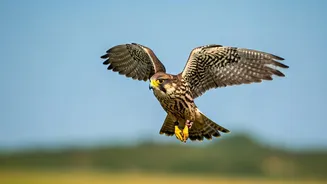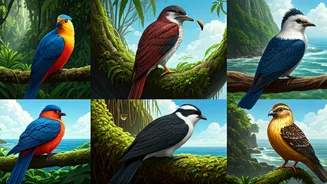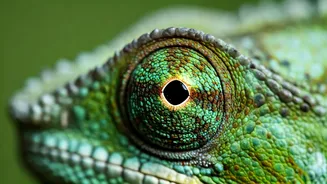Fabulous Fox!
The fox, a cunning member of the canine family, is known for its reddish-brown fur, bushy tail, and adaptable nature. Foxes are found across the globe,
inhabiting diverse environments, from forests and grasslands to urban areas. They are opportunistic omnivores, feeding on a wide range of foods, including rodents, birds, insects, and fruits. Foxes are primarily nocturnal hunters, using their keen senses of hearing and smell to locate prey. Their ability to adapt has allowed them to thrive in various regions, often finding clever ways to survive in human-altered landscapes. Their intelligence is apparent in their problem-solving skills, and they demonstrate social behaviors within family groups.
Fearless Falcon!
Falcons are birds of prey, admired for their incredible speed and aerial prowess. Known for their streamlined bodies and sharp talons, they are built for hunting. These birds are found on nearly every continent, and they have adapted to various environments, from open plains to mountainous regions. The peregrine falcon, famed for its diving speed, can reach over 200 mph during a stoop. Falcons possess excellent vision, enabling them to spot prey from great distances. They typically feed on birds and small mammals, employing their speed and agility to capture their meals. Falcons are often solitary hunters, though they may form pairs during the breeding season. Conservation efforts are crucial in protecting these magnificent birds.
Friendly Frog!
Frogs, amphibians known for their moist skin and hopping locomotion, inhabit a wide variety of habitats, ranging from wetlands and forests to deserts. There are thousands of frog species around the world, each adapted to their specific environments. Frogs undergo metamorphosis, starting as aquatic tadpoles and transforming into their adult forms. They are carnivores, feeding primarily on insects and other invertebrates. Their skin plays a vital role in respiration, and they are sensitive to environmental changes. Many frog species are indicators of ecosystem health, as they are susceptible to pollution and habitat destruction. Conservation is essential to help keep these amphibians from facing threats.
Fluffy Flamingo!
Flamingos are striking wading birds easily recognized by their vibrant pink feathers, long necks, and unique beaks. Found in tropical and subtropical regions across the globe, they often inhabit saline or alkaline lakes and lagoons. Their pink coloration comes from the pigments found in the algae and small crustaceans they eat. Flamingos filter-feed, using their specialized beaks to strain food from the water. They are social birds, often living in large flocks that can include thousands of individuals. Their synchronized movements during feeding and mating rituals are quite remarkable. Flamingos build nest mounds and raise their chicks in colonies, making them a significant sight.
Fantastic Ferret!
Ferrets, members of the weasel family, are long, slender mammals. They are known for their playful personalities and are often kept as pets. Historically, ferrets have been used for hunting and controlling rodent populations. Ferrets have a strong scent and produce a musky odor, which is natural to the species. They are primarily carnivorous, feeding on meat-based diets. They are crepuscular animals, active during dawn and dusk. They live in burrows or dens. Proper care of ferrets involves providing a suitable environment and appropriate diet. There are different breeds and colors, each with its unique characteristics.
Fearsome Fossa!
The fossa is a carnivorous mammal native to Madagascar. It resembles a cross between a cat and a civet, possessing a long, lithe body and a long tail. Fossas are the largest mammalian predators on Madagascar, playing a key role in the island's ecosystem. They are agile climbers, spending a lot of time in trees, and are known for their ability to hunt lemurs. They feed on lemurs, other mammals, birds, and reptiles. Fossas are solitary animals, except during mating season. Conservation efforts are crucial, as habitat loss and deforestation threaten their survival. Their unique adaptation makes them an important part of their ecosystem.
Friendly Fish!
The term 'fish' can refer to a large variety of creatures living in water. Fish are aquatic vertebrates, characterized by their fins, gills, and scales. They inhabit oceans, rivers, lakes, and other aquatic environments. Fish exhibit a vast diversity of shapes, sizes, and colors, with each species adapted to its specific habitat. They utilize gills to extract oxygen from the water. Fish play crucial roles in aquatic ecosystems, serving as both predators and prey. They are a food source for humans and other animals. Conservation measures are vital to protect fish populations from overfishing, habitat destruction, and water pollution.







